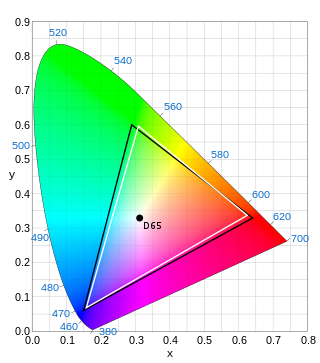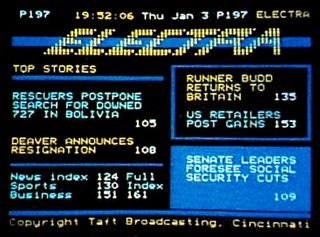Related Research Articles

Video is an electronic medium for the recording, copying, playback, broadcasting, and display of moving visual media. Video was first developed for mechanical television systems, which were quickly replaced by cathode-ray tube (CRT) systems, which, in turn, were replaced by flat-panel displays of several types.
NAPLPS is a graphics language for use originally with videotex and teletext services. NAPLPS was developed from the Telidon system developed in Canada, with a small number of additions from AT&T Corporation. The basics of NAPLPS were later used as the basis for several other microcomputer-based graphics systems.

Telidon was a videotex/teletext service developed by the Canadian Communications Research Centre (CRC) during the late 1970s and supported by commercial enterprises led by Infomart in the early 1980s. Most work on the system ended after 1985, having failed to build critical mass.

Videotex was one of the earliest implementations of an end-user information system. From the late 1970s to early 2010s, it was used to deliver information to a user in computer-like format, typically to be displayed on a television or a dumb terminal.

ITU-R Recommendation BT.601, more commonly known by the abbreviations Rec. 601 or BT.601, is a standard originally issued in 1982 by the CCIR for encoding interlaced analog video signals in digital video form. It includes methods of encoding 525-line 60 Hz and 625-line 50 Hz signals, both with an active region covering 720 luminance samples and 360 chrominance samples per line. The color encoding system is known as YCbCr 4:2:2.

In a raster scan display, the vertical blanking interval (VBI), also known as the vertical interval or VBLANK, is the time between the end of the final visible line of a frame or field and the beginning of the first visible line of the next frame or field. It is present in analog television, VGA, DVI and other signals.
Broadcasttelevision systems are the encoding or formatting systems for the transmission and reception of terrestrial television signals.
Antiope was a French teletext standard in the 1980s. It also formed the basis for the display standard used in the French videotex service Minitel. The term allegedly stood for Acquisition Numérique et Télévisualisation d’Images Organisées en Pages d’Écriture, which could be loosely translated as Digital Acquisition and Remote Visualization of Images Organized into Written Pages.

480i is the video mode used for standard-definition digital video in the Caribbean, Japan, South Korea, Taiwan, Philippines, Myanmar, Western Sahara, and most of the Americas. The other common standard definition digital standard, used in the rest of the world, is 576i.
Overscan is a behaviour in certain television sets in which part of the input picture is cut off by the visible bounds of the screen. It exists because cathode-ray tube (CRT) television sets from the 1930s to the early 2000s were highly variable in how the video image was positioned within the borders of the screen. It then became common practice to have video signals with black edges around the picture, which the television was meant to discard in this way.

Teletext, or broadcast teletext, is a standard for displaying text and rudimentary graphics on suitably equipped television sets. Teletext sends data in the broadcast signal, hidden in the invisible vertical blanking interval area at the top and bottom of the screen. The teletext decoder in the television buffers this information as a series of "pages", each given a number. The user can display chosen pages using their remote control. In broad terms, it can be considered as Videotex, a system for the delivery of information to a user in a computer-like format, typically displayed on a television or a dumb terminal, but that designation is usually reserved for systems that provide bi-directional communication, such as Prestel or Minitel.

Electra was a teletext service in the United States that was in operation from 1982 up until 1993, when it was shut down due to a lack of funding, and discontinuation of teletext-capable television sets by the only US television manufacturer offering teletext capability at the time, Zenith. It was owned, operated and maintained by Cincinnati-based Taft Broadcasting and Tulsa, Oklahoma-based Satellite Syndicated Systems (SSS), later known as Tempo Enterprises, in cooperation with cable/satellite TV station Superstation WTBS, who carried Electra's data on their vertical blanking interval. SSS's own TV network, the Satellite Program Network, carried the service before it was shut down in 1989. The service was also available to C-band satellite dish users via the Galaxy 1 and Satcom 3R satellites.
Copy Generation Management System – Analog (CGMS-A) is a copy protection mechanism for analog television signals. It consists of a waveform inserted into the non-picture vertical blanking interval (VBI) of an analogue video signal. If a compatible recording device detects this waveform, it may block or restrict recording of the video content.

ExtraVision was a short-lived teletext service created and operated by the American television network CBS in the early to mid-1980s. It was carried in the vertical blanking interval of the video from local affiliate stations of the CBS network. It featured CBS program information, news, sports, weather, even subtitling for CBS programming. ExtraVision could also have its pages customized by the local affiliate station carrying it, for such things as program schedules, local community announcements, and station promotions. WGBH Boston, a pioneer in assisting the deaf and hard-of-hearing with closed captioning, also provided content for those audiences to ExtraVision and assisted in providing captioning for CBS programming via ExtraVision.

World System Teletext (WST) is the name of a standard for encoding and displaying teletext information, which is used as the standard for teletext throughout Europe today. It was adopted into the international standard CCIR 653 of 1986 as CCIR Teletext System B.
Norpak Corporation was a company headquartered in Kanata, Ontario, Canada, that specialized in the development of systems for television-based data transmission. In 2010, it was acquired by Ross Video Ltd. of Iroquois and Ottawa, Ontario.

CCIR System B was the 625-line VHF analog broadcast television system which at its peak was adopted by more than one hundred countries, either with PAL or SECAM colour. It is usually associated with CCIR System G for UHF broadcasts.

JTES, the Japanese Teletext Specification, is a protocol used for encoding teletext pages, as well as other types of digital data, within the vertical blanking interval (VBI) of an analog video signal in Japan. It was adopted into the international standard CCIR 653 of 1986 as CCIR Teletext System D.
NBC Teletext was a teletext service provided by the American TV network NBC from 1981 to 1985, based on the NABTS standard.
References
- ↑ Astle, B. (September 1983). RCA Engineer – Teletext standards in North America (PDF). RCA Corporation. p. 15.
- ↑ "Recommendation ITU-R BT.653-3 (02/1998) Teletext systems" (PDF). itu.int.
- ↑ "Norpak – TES3/NABTS". October 10, 2006. Archived from the original on 10 October 2006.
- 1 2 Gillies, Donald (1989). Technological Determinism In Canadian Telecommunications: Telidon Technology, Industry and Government. Ryerson Polytechnical Institute. p. 6. doi:10.22230/cjc.1990v15n2a549 (inactive 31 January 2024).
{{cite book}}: CS1 maint: DOI inactive as of January 2024 (link) - 1 2 3 4 "mb21 – ether.net – The Teletext Museum – World". teletext.mb21.co.uk. Retrieved 2022-12-15.
- 1 2 3 4 Enterprise, I. D. G. (1983-04-25). Computerworld. IDG Enterprise.
- 1 2 "NBC Teletext | UX | Portfolio | Videotex, Prototyping, Thought Leadership, Website Design, Consumer". www.jcvtcs.com. Retrieved 2022-12-15.
- 1 2 Graziplene, Leonard R. (2000). Teletext: Its Promise and Demise. Lehigh University Press. ISBN 978-0-934223-64-5.
- 1 2 Technology, United States Congress House Committee on Science and Technology Subcommittee on Science, Research, and (1984). Developing Technologies for Television Captioning: Benefits for the Hearing Impaired : Hearing Before the Subcommittee on Science, Research, and Technology of the Committee on Science and Technology, U.S. House of Representatives, Ninety-eighth Congress, First Session, November 9, 1983. U.S. Government Printing Office.
{{cite book}}: CS1 maint: multiple names: authors list (link) - ↑ "Teletext Services". The New York Times. 1982-06-26. ISSN 0362-4331 . Retrieved 2022-12-15.
- 1 2 "Teletext News Briefs" (PDF). World Radio History. March 1983. Retrieved 4 August 2023.
- 1 2 Technology, United States Congress House Committee on Science and Technology Subcommittee on Science, Research, and (1984). Developing Technologies for Television Captioning: Benefits for the Hearing Impaired : Hearing Before the Subcommittee on Science, Research, and Technology of the Committee on Science and Technology, U.S. House of Representatives, Ninety-eighth Congress, First Session, November 9, 1983. U.S. Government Printing Office.
{{cite book}}: CS1 maint: multiple names: authors list (link) - ↑ "Intercast", The Free Dictionary, retrieved 2022-12-15
- ↑ "Norpak – NABTS Data Throughput". October 20, 2006. Archived from the original on 20 October 2006.
